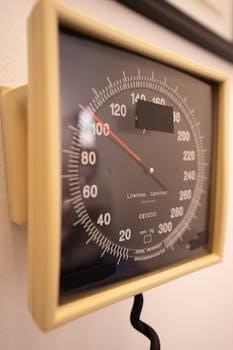
Seca Weight Scale Manual⁚ A Comprehensive Guide
This comprehensive guide provides essential information for operating and maintaining Seca weight scales․ It covers various models, features, and functionalities․ The guide will also detail proper calibration, troubleshooting, and safety precautions for accurate and reliable measurements․
Understanding Seca Scale Models and Their Applications
Seca offers a diverse range of scales, each designed for specific applications; Models like the Seca 864 are prevalent in hospitals and nursing facilities, known for their Class I medical product calibration․ The Seca 874 utilizes four load cells for accurate weight detection, even accommodating the weighing of babies held by adults, thanks to its 2-in-1 function․
The Seca 777 measuring station integrates weight and height measurements, calculating Body Mass Index (BMI) automatically․ For bariatric patients, Seca provides wheelchair scales, ensuring effortless weighing․ The Seca 334, 354, 374, 383, 727, and 728 models cater specifically to determining the mass of children, ensuring accurate tracking of growth․ These scales find applications in various healthcare settings, promoting accurate weight management and monitoring․
The Seca 703s combines weight and height measurement in one time-saving step․ Understanding these model-specific features is vital for selecting the appropriate scale and ensuring accurate, reliable data collection․

Key Features and Functionality
Seca scales boast features like tare functionality for accurate measurements, BMI calculation for health assessment, and EMR connectivity for data transfer․ These functionalities enhance usability and efficiency in various professional settings requiring precise weight monitoring․
Tare Functionality and Its Use
The tare function on Seca scales is an essential feature that allows users to accurately weigh subjects by subtracting the weight of any additional load․ This is particularly useful in medical settings where items like blankets, diapers, or even the weight of an adult holding a child need to be excluded from the final measurement․
To use the tare function, simply place the item you wish to exclude on the scale platform before the subject․ Then, press the “Tare” button․ The scale will reset to zero, effectively negating the weight of the item․ Now, place the subject on the scale, and the displayed weight will only reflect the subject’s mass, providing a precise and accurate reading․
This feature is crucial for obtaining accurate birth weights of babies, monitoring weight gain in infants, or tracking weight changes in patients with medical conditions․ By using the tare function, healthcare professionals can ensure reliable data collection and make informed decisions based on accurate weight measurements․
The tare function enhances the versatility of Seca scales, making them invaluable tools for healthcare professionals, fitness enthusiasts, and individuals who require precise weight measurements in various applications․
BMI Calculation and Interpretation
Many Seca scales feature integrated Body Mass Index (BMI) calculation, offering a quick assessment of weight relative to height․ BMI is calculated using the formula⁚ weight (kg) / [height (m)]2․ Some scales require manual height input, while others, like the Seca 777, integrate height measurement for automatic BMI calculation․ This eliminates potential errors from manual data entry and streamlines the assessment process․
The calculated BMI value provides an indication of whether an individual is underweight, normal weight, overweight, or obese․ The World Health Organization (WHO) provides standard BMI ranges for interpretation․ A BMI below 18․5 indicates underweight, 18․5-24․9 indicates normal weight, 25-29․9 indicates overweight, and 30 or higher indicates obesity․
It’s important to note that BMI is a screening tool and doesn’t directly measure body fat․ Factors like muscle mass, age, sex, and ethnicity can influence BMI․ Therefore, BMI should be interpreted in conjunction with other health assessments․ Nevertheless, it serves as a valuable initial indicator for identifying potential weight-related health risks and guiding further evaluation․
Seca scales with BMI functionality simplify the process of assessing weight status, enabling healthcare professionals to efficiently monitor patients’ health and provide appropriate guidance․

Calibration and Maintenance
Proper calibration and regular maintenance are crucial for ensuring the accuracy and longevity of Seca weight scales․ Calibration verifies the scale’s accuracy against known standards, while maintenance involves cleaning and inspection to prevent malfunctions and ensure optimal performance․
Calibration Procedures for Seca 354/364 Baby Scales
The Seca 354 and 364 baby scales require careful calibration to ensure accurate weight measurements, critical for infant health monitoring․ This software-driven procedure necessitates using two calibrated test weights․ Begin by ensuring the scale is placed on a flat, stable surface to avoid any interference with the readings․
The calibration process involves accessing the scale’s calibration mode, typically through a specific button combination or menu option as detailed in the user manual․ Follow the on-screen prompts to initiate the calibration sequence․ The scale will guide you through placing the first test weight, allowing it to stabilize, and confirming the reading․
Repeat this process with the second test weight, ensuring accurate placement and stability before confirming․ Upon completing both weight measurements, the scale will calculate and adjust its internal settings to align with the known standards․ Once calibration is finished, verify the accuracy by weighing a known object and comparing the result․
Regularly scheduled calibration checks, as recommended in the manual, will maintain the scale’s precision․ This ensures reliable data for tracking infant growth and development, essential for healthcare professionals and parents alike․
Troubleshooting Common Issues
Seca scales, while reliable, may occasionally encounter operational issues․ A frequent problem involves inaccurate weight readings․ This could stem from an uncalibrated scale or placement on an uneven surface․ Ensure the scale rests on a flat, stable area and perform a calibration check following the manual’s instructions․ Battery issues can also lead to inaccurate readings or failure to power on․
If the display shows an error message, consult the user manual for specific troubleshooting steps related to that code․ Overload errors occur when the weight exceeds the scale’s capacity; remove the excess weight immediately․ Connectivity problems with EMR systems may arise due to incorrect settings or outdated software․ Verify the connection settings and update the software as needed․
Another common issue is the scale not turning on․ Check the power source, replace batteries, or inspect the power adapter for damage․ If the tare function malfunctions, ensure no weight is on the scale when initiating the tare process․ For persistent issues, contact Seca’s customer support or an authorized service technician for professional assistance․
Regular maintenance and adherence to the user manual’s guidelines can prevent many of these problems, ensuring accurate and reliable performance․
Safety Precautions and Guidelines
Using Seca scales safely and effectively requires adherence to specific precautions․ Always place the scale on a flat, stable surface to prevent tipping and ensure accurate measurements․ Avoid using the scale in wet or humid environments, as moisture can damage the electronic components and pose a safety hazard․ Regularly inspect the scale for any signs of damage, such as cracks, loose parts, or frayed cords․ If damage is detected, discontinue use immediately and contact a qualified technician for repair․
When weighing infants or children, never leave them unattended on the scale․ Always provide constant supervision to prevent falls or injuries․ Ensure the scale’s capacity is not exceeded, as overloading can damage the device and compromise accuracy․ When cleaning the scale, use a soft, damp cloth and avoid harsh chemicals or abrasive cleaners that could damage the surface or internal components․
Properly dispose of used batteries according to local regulations․ Keep the scale away from heat sources and direct sunlight to prevent overheating and damage․ If using a scale with EMR connectivity, ensure data privacy and security protocols are followed․ Regularly review the user manual for specific safety instructions and guidelines related to your Seca scale model․ Following these precautions ensures safe and reliable operation, protecting both users and the equipment․

EMR Connectivity and Data Transfer
Seca scales increasingly offer EMR (Electronic Medical Record) connectivity, streamlining data transfer and improving workflow efficiency․ This feature allows seamless integration of weight and measurement data directly into patient records, reducing manual entry errors and saving time․ Seca scales often utilize various connectivity options, including WLAN, Bluetooth, and USB, to interface with EMR systems․
To establish EMR connectivity, ensure that the scale is properly configured and paired with the EMR software․ Consult the Seca scale manual for specific instructions on setting up the connection and configuring data transfer protocols․ Data security is paramount; therefore, it’s crucial to implement appropriate security measures to protect patient information during transmission․
Regularly verify that the data is being accurately transferred and stored in the EMR system․ Some Seca scales allow for customized data fields and formats, enabling tailored integration with different EMR platforms․ Troubleshooting connectivity issues may involve checking network settings, software configurations, and cable connections․ Proper implementation of EMR connectivity enhances data accuracy, improves clinical decision-making, and ultimately contributes to better patient care․ Refer to your EMR system’s documentation for compatibility and integration details․ Always ensure compliance with HIPAA and other relevant data privacy regulations․

Where to Find Seca Scale Manuals and Support
Locating the correct Seca scale manual and accessing reliable support is crucial for optimal use and maintenance․ The primary resource for Seca scale manuals is the official Seca website․ Navigate to the “Downloads” or “Support” section of the website and search for your specific scale model number․ Manuals are typically available in PDF format for easy download and viewing․
Additionally, authorized Seca dealers and distributors often provide access to manuals and offer technical support․ Contact your local dealer for assistance with finding the correct manual or resolving any technical issues․ Online forums and communities dedicated to medical equipment may also contain user-shared manuals and troubleshooting tips․
When seeking support, be prepared to provide your scale’s model number, serial number, and a detailed description of the issue you are experiencing․ Seca’s customer service department can be contacted directly through their website or by phone․ They offer comprehensive support services, including troubleshooting, repair assistance, and product information․ Remember to always refer to the official Seca resources for the most accurate and up-to-date information regarding your scale model․ Proper documentation ensures effective use and prolongs the lifespan of your Seca scale․